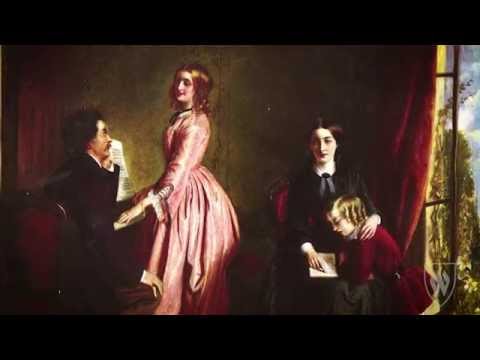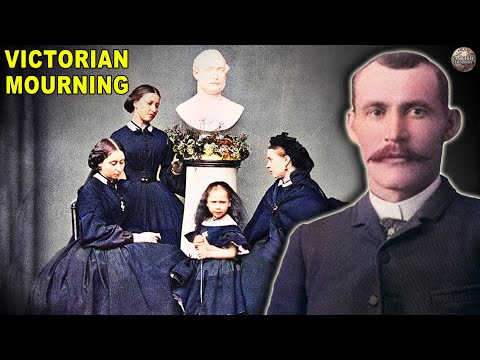Here are ten of the ways in which the debilitating disease shaped Victorian society.
10 High Death Rates
The most obvious way in which tuberculosis affected Victorian society was, of course, the number of lives it took. It’s even believed to be the leading cause of death by any microbial pathogen in history. At the turn of the 19th century, around 50 million people worldwide were openly infected with it. What the Victorians didn’t know for a long time is that the disease, which attacks the lungs and damages various organs, is highly infectious. The poor sanitation and hygiene standards of the time created the perfect breeding ground for its proliferation. Watch this video on YouTube Two of the worst affected places were the cities of London and New York. In Victorian England, it claimed around one in five lives of the entire population, with similar numbers in the United States. As one of the leading causes of death during the 19th century, it’s little wonder tuberculosis affected so many areas of society.[1]
9 Beauty and Aesthetics
When tuberculosis was at its peak during the early to mid-19th century, it was heavily glamorized, despite it causing around 25% of deaths in Europe. Some of the physically apparent symptoms of the disease, such as emaciation and wasting away, were aligned with existing Victorian ideas of attractiveness. Subsequently, tuberculosis quickly became associated with beauty. Sufferers usually had a thin, fragile frame, pale skin with rosy cheeks, red lips, and sparkling eyes. These features were the ideal beauty standard of the time, which left many wishing to imitate it through the use of makeup. Among the upper class of Victorian society, it was generally believed that a woman’s level of attractiveness could determine how likely she was to suffer from tuberculosis. The disease simply enhanced features considered beautiful in women. Since makeup was usually associated with prostitutes and actresses, however, most upper-class ladies actually hoped to contract the disease![2]
8 The Fashion
With the disease and its effects having become entwined with the ideals of beauty, tuberculosis soon played a role in the nature of 19th-century fashion. During the first half of the 1800s, consumption was believed to be caused by “bad airs” in the environment, as well as the result of a hereditary predisposition. At this time, when admiration for the pale, wasting appearance was at its peak, fashion trends tended to emulate and highlight symptoms of the disease. Pointed corsets were worn by women to emphasize tiny waists and were paired with huge, voluminous skirts to further show off the waifish look. When tuberculosis came to be recognized as a bacterial disease during the second half of the 19th century, it still continued to have a huge influence over fashion. Large-scale public health campaigns were implemented in an effort to prevent the spread, and doctors claimed that large skirts could sweep up germs from the street and bring them into the home. Corsets were also criticized for limiting blood circulation and the movement of the lungs, which was quickly reconsidered to exacerbate tuberculosis. Even men’s fashion came under attack. Extravagant, bushy beards, sideburns, and mustaches that were at the height of fashion at the beginning of the century, were deemed too dangerous. The clean-shaven look was initially adopted primarily by physicians and surgeons, but the rest of male society soon followed.[3]
7 Literature
The prevalence of tuberculosis within 19th-century European society led to its depiction in the various celebrated literary works of the time. These works certainly helped to shape the romantic image that the Victorians held of the disease. Tragic fictional icons who fell to the disease were common in 19th-century literature, including Katerina Ivanova in Dostoevsky’s Crime and Punishment and Fantine from Victor Hugo’s Les Misérables. A strange belief about tuberculosis also surrounded celebrated writers of the time. The prevalence of the disease meant that numerous individuals of extraordinary talent were also among its victims. This led to the notion that there was a link between tuberculosis and creative genius. Some notable writers among the mass of sufferers included Robert Louis Stevenson, John Keats, and Emily Brontë. All were said to have improved creative power as their physical conditions deteriorated. Unsurprisingly, this caused many literary and artistic types of the time to wish to contract tuberculosis.[4]
6 Entertainment
The “tragic beauty” associated with tuberculosis also worked its way into the sphere of 19th-century entertainment. The upper crust of Victorian society would often frequent the opera, where heart-breaking stories of the beautiful victims of consumption would be portrayed. Two popular operas that explored the themes of the disease included La Traviata and Giacomo Puccini’s La Boheme. Watch this video on YouTube Based on a novel, the tragic story of La Traviata is a particularly romantic representation of tuberculosis. It follows the tale of two lovers: the young and beautiful courtesan Violetta and her secret admirer Alfredo. The story’s themes of love, joy, youth, and beauty are accompanied by the looming threat of disease and death, with Violetta’s consumption playing an increasingly large role as the tale progresses. Given that tuberculosis was so often represented within romantic contexts in the arts, it’s little wonder that the Victorians came to view it as a romantic disease.[5]
5 Art
As with other areas of the creative sphere, the imagery depicted in many artworks produced by 19th-century artists was influenced by their own experiences of tuberculosis. Works of the 19th-century artist Ferdinand Hodler reflect his tragic childhood encounters with the disease, which had robbed him of his entire family. Some of his most significant works in this respect include “The Convalescent,” “Night Hodler,” and “A Troubled Soul.” It was a similar story for Edvard Munch, which inspired his works such as “The Sick Child” and “Sick Chamber.” Works such as these and others were significant in developing the more morbidly tragic notions that the Victorians associated with the illness. Watch this video on YouTube As with literary artists, tuberculosis was associated with artistic genius on the canvas too. It was speculated that the low-grade fever accompanying tuberculosis might have been responsible for heightened perception and bursts of inspiration and insight.[6]
4 An Obsession with Death
Death was a huge part of life for the Victorians, and as such, they were obsessed with it. Given that tuberculosis was one of society’s biggest killers (although, admittedly, there were a few!), the disease likely played a small yet significant role in fueling this obsession. The Victorians were ritualistic in their approach toward death and mourning, and it became a way of life for most. Watch this video on YouTube The deathbed itself became an important focal point around which the departed’s last words were highly valued. In fact, “deathbed watches” and notions of a “good death” often featured prominently in the literature of the time, particularly the works of Charles Dickens. Complex codes of mourning were in place, including the requirement that a grieving woman must only wear black for exactly twelve months and a day. Jewelry created from the locks of the deceased’s hair was also produced, along with other mementos, such as death masks and portraits, which were given a place of pride around the home. In Victorian society, death, loss, and grief were simply seen as an inevitable and integral part of life.[7]
3 Science
Although tuberculosis has been around for thousands of years, it wasn’t until the mid-19th century that scientists began to recognize that its transmission wasn’t simply the result of “bad airs” or genetic predisposition. It was the likes of the French chemist Louis Pasteur and the British surgeon Joseph Lister who developed germ theory around this time. However, while they were key figures in determining that germs cause disease, it was the German physician Robert Koch who first linked specific bacteria to certain diseases. Watch this video on YouTube It was in 1882 that Koch announced his discovery that Tubercle bacillus caused tuberculosis. His experiments involving culturing and inoculating animals with the bacilli completely revolutionized the understanding of the disease and others like it. He also found that a mixture of saliva and mucus coughed up from the respiratory tract was the main way of spreading the disease. This led to huge changes in scientific understanding and the fields of medicine, hygiene, and sanitation in Victorian society.[8]
2 Medicine and Hygiene
Koch’s discovery meant that Victorian society became acutely aware of the fact that tuberculosis was not only contagious but also very much tied to personal and public standards of hygiene. This meant the previous reliance on treatments such as a “change of air” and bloodletting would no longer cut it. Instead, public health measures were put in place to stop the spread of tuberculosis and other contagious diseases. These included the provision of clean water, waste removal, and separate sewage systems. New legislation was also implemented for improved housing to reduce overcrowding. Watch this video on YouTube Within the medical field, improvements took place very rapidly. Technological equipment was developed to detect and treat diseases, and sterilization and antiseptic surgical procedures started to take place. In addition, specialized surgical instruments and techniques began to be developed. Ultimately, Koch’s discoveries started a chain reaction that led to a complete overhaul of the Victorian medical profession and the growth of the medical industry.[9]
1 Social Reform
With growing awareness of the importance of hygiene and decent sanitation to prevent the spread of tuberculosis, it quickly became apparent that the poorer classes were the most at risk. Although concerns surrounding the living and working conditions of the poor were by no means initiated by Koch’s discovery, it certainly emphasized the importance of the matter. Fifty new statutes on housing were, therefore, put into place during the second half of the 19th century. The main target was to reduce overcrowding and improve the overall standard of living for the poorest members of society. Watch this video on YouTube Various measures, reforms, and legislation were also put into place or updated to help the working class. Penny savings banks were established, early forms of insurance policies were offered, and communal resources were made available to assist the poorest members of Victorian society. Their vulnerability to tuberculosis and other diseases had further highlighted a burgeoning need to improve their living standards.[10]
























